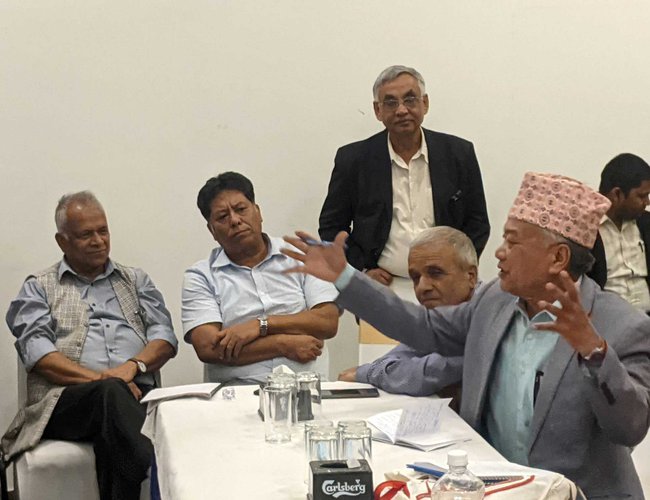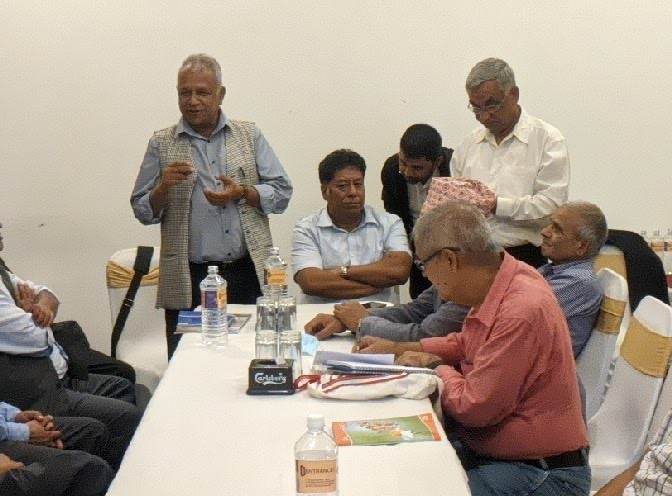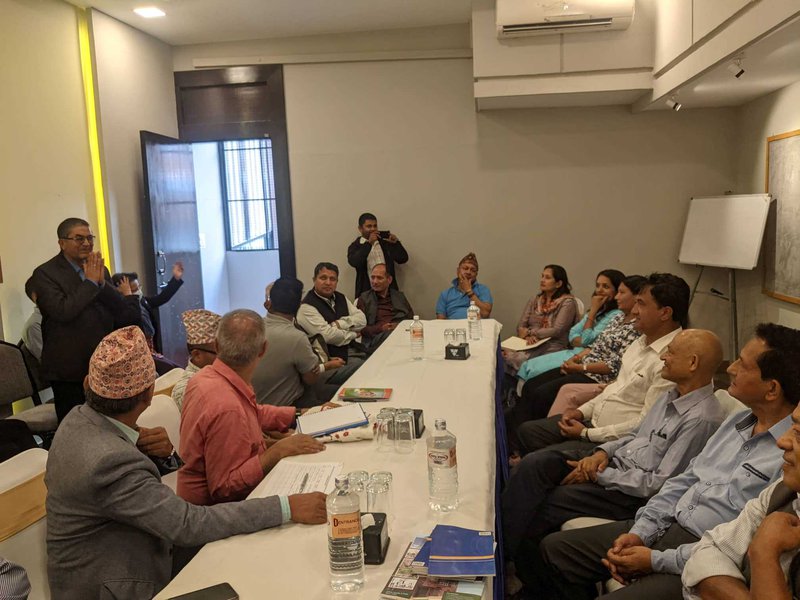
Eroding quality of soil, scarcity of chemical fertilizers, improved seeds and adequate water, Nepal’s agriculture productivity has drastically declined to result in a major threat to food security. The rising energy prices after the Russian invasion of Ukraine and changing rain patterns due to climate change have further aggravated the crisis of food security. In a recently concluded discussion, experts warned that a major food crisis is close to the horizon.
According to National Demographic Health Survey Report 2020, 4.6 million people are food-insecure, with 20 percent of households mildly food-insecure, 22 percent moderately food-insecure, and 10 percent severely food-insecure. Similarly, International LaborOrganization’s report showed that agriculture provides livelihoods for 68 percent of Nepal's population, accounting for 34 percent of the GDP. Nevertheless, Nepal struggles to produce an adequate supply of food for its citizens.

Similarly, thirty-six percent of Nepali children under the age of 5 years suffer from chronic malnutrition, or stunting, which causes debilitating effects such as blindness, brain damage, and infectious diseases, which can result in lifetime damage.
Over the last few years, some policy interventions have helped increase people’s access to food through increasing productivity. However, large numbers of farmers still have limited access to improved seeds, chemical fertilizers, organics fertilizer, new technologies and market opportunities. Declining agricultural production has depressed rural economies and increased widespread hunger and urban migration.
Along with other factors, Nepal’s food production has been declining due to impacts of climate change including scarcity of water and costly energy.
As the issue of food security is looming large with the crisis of energy, Niti Foundation, a non-profit organization engaged in strengthening Nepal’s policy process through collaborative research, innovative policy adoption, and enhanced policy choice, makes efforts to explore it.
Organized by the Foundation, experts, civil society leaders, former top bureaucrats, experts and scientists shared their views on what policy interventions require to avoid the crisis in a discussion program on Food Scarcity -Climate Change -Water and Energy nexus.
Participated by sectoral experts, and chief of the concerned associations like Farmers, Irrigation, Forest, Energy and Water, the first informal discussion program raise these issues on policy reforms, implementation, and priority at national, province and local levels of governments.
Opening Statement
Opening the discussion, Mohan Das Manandhar, Executive Director of Niti Foundation, highlighted the need to develop policy broadly looking at Food Scarcity -Climate Change -Water and Energy nexus. He said that Nepal does have policies in each and every sector. However, the implementation part is non-existent. “Whether it was in Panchayat under an active monarchy or current federal republic, the governments announced a number of policies on major issues like water, climate and energy. No one care about their implementation.”
Manandhar explained that Nepal is known as a country with more policies with non-implementation.
“Established in 2010, Niti Foundation (‘Niti’) is a Nepali non-profit organization engaged in strengthening Nepal’s policy process through collaborative research, innovative policy adoption, enhanced policy choice and implementation with local collaboration,” said Manandhar.
“To identify, support, and convene present and future leaders in public policy reform, to support networking and coalition building for public policy reform; and to promote Nepali organizations and individuals that work on public policy reform,” said Manandhar. “This discussion is one of the parts to achieve the overall objective in these agenda to have a food security goal.”
“Our approach contributes to the larger discourse on innovative methods to achieve ‘more public’ policy with just and fair outcomes. Nepal does have bundles of policy on agriculture, water, energy and climate change.”
“We are providing support for Nepal’s policymakers, analysts, and public intellectuals to support and conduct research, advocacy, and action on major policy issues. Whether it be a climate change, water
As Nepal has already federalized, provincial and local governments have given enormous power, most of our civil society organizations are yet to change their structure as per the new inclusive constitution. Niti Foundation believes that local actors should be at the forefront of the policymaking process from agenda-setting to policy formulation, implementation, and evaluation.
“We believe that locally-rooted process ensures wider ownership among policy actors and implementers, thereby improving their effective implementation and accountability. “Given the current situation, analyzing the current policies and implementation is the first to step to understanding the nexus among food security, climate change, water and energy is relevant,” said Manandhar.
“I encountered farmer in Kailali complaining about the rising prices of diesel and cost of water lifting through water pump to irrigate the land. I met farmers who expressed their helplessness to secure chemical fertilizer and high-yielding seeds to increase production. Similarly, I encountered farmers who have seen a drastic shift in the rain pattern and faced a shortage of water. Of course, Nepal has policies at all levels to deal with the problems. It is sad to say that policies are rarely made for implementation,” said Manandhar.
“Our aim thus is to develop the policy led by local government and owned by the local leaders. Most importantly, they should be implemented. “We had seen in the past policy statements pronounced by the Kings and hanged at the main street of the capital. However, they were rarely implemented. Even sixteen years after the abolition of the old monarchical and centralized system, the trends continue. “We must change this now.”
Moderated by Purshottam Ghimire and presided by former minister Ganesh Shah, Ghimire called participants to share the issues, policies and state of implementation.
He said that the current energy crisis and the climate crisis will lead to a food crisis in the near future. At a time when federal, provincial and local governments are giving high priority to increasing the productivity in the agriculture sector, the policies do not meet their commitments. He said that the ground reality is different than the policy.
Question On Climate Change
Climate change is an existential crisis that requires an immediate, transformational shift away from fossil fuels. Climate change has a direct linkage with water and water with food and energy. Despite such co-relations, Nepal’s policies are dealing with them separately. Ministry of Forest and Environment formulate the policy issue on climate change. Ministry of Agriculture Development and Livestock and the Ministry of Energy, Hydropower and Irrigation is responsible for the implementation. Similarly, provincial and local governments have their own mandate and policies.
Keshab Sharma, former Director-General of Hydrology and Meteorology, said climate change will affect water levels in the country in the coming days and will be a key factor affecting agriculture productivity. He said that the rising temperature will intensify the GLOF reducing the level of water in the river. This will hamper irrigation. “We need to have a policy for research on hydrology and meteorology.
“Such policies should say how Nepal can use the water in the future for irrigation and food security. “
At a time when fossil fuel is a major factor in increasing CO2 and increase in the fossil fuel, the policymakers have the right time to go for an energy transition from fossil fuel to clean energy from hydropower and other renewable energy sources.
Udhav Adhikari, president of the National Farmers Irrigation Association, said that timely rainfall, cheaper energy, and timely supply of fertilizers are major factors to irrigate the land and increase production. He said that the policies are yet to be formulated to integrate them.
“Climate change is affecting rainfall, decreasing the water level and high prices of energy are affecting the irrigation. Climate, water, energy and food security are integrated into each other. There need to have a common and integrated approach,” said Adhikary
He said that the current policies do not address all these agendas. “Agriculture development has always been the main priority sector of all three tiers of governments. “They allocate a huge budget to implement the policies and programs. However, the policies do not give priority to the farmers who hold the small land but to those big landholders and a handful of land owners,” said Adhikary. “At a time when more than 15 million farmers are out of the policy basket, how can one think to achieve the food security? “
The policy should review and conduct a situational analysis of the political atmosphere and farmer’s level to make the engagement of farmers with the federal, provincial, and local government more effective.
Federal, provincial and local governments need to work in cooperation and collaboration to address the problems. “The government needs to clarify their position on organic agriculture and implement the recommendations of the Study Team on Organic Agriculture formed by Ministry of Agriculture and Livestock Development, particularly the establishment of an independent and resourceful organic board”.
“Since the government is in the process of revising the agricultural policy, all different stakeholders do their own exercise in establishing their agenda in the revised agricultural policy, national agricultural strategy and land. “
Land, Energy and Productivity
As the fuel crisis hits hard, various sectors pressurize the government to shift from LPG usage to hydro and renewable energy in cooking. Similarly, the government is also promoting replacing petrol vehicles with electricity announcing to increase in charging stations, and tariff reductions in irrigation. This way Nepal is moving quickly to transition to zero-emission. They are major commitments Nepal has promised through its policy documents including National Determined Contributions and Social Development Goals (SDG).
However, it is not easier than done. Given the quality of electricity distribution system, electric warring in rural households, and overwhelming domination of petroleum vehicles. Lowering, CO2 emissions can prevent the GLOF.
Professor Jagganth Shrestha, a leading energy expert from the Institute of Engineering Tribhuwan University, holds the view that food security has nexus with climate, energy and water. He pointed out Nepalese traditional saying Krishi, Mal and Jal (Agriculture, Fertilizer and water) in the present context. Energy is a prerequisite to lift water, producing fertilizer and increasing productivity. He said that Nepal has over 6000 rivers, and over 23000 rivulets covering over 90000 square kilometers of land. However, Nepal’s irrigation is the lowest with 147,000 cultivable lands that do not have access to irrigation.
Shrestha argues that Nepal can change things simply by promoting one house and one energy source. “We have solar power, wind power and hydropower. By properly exploiting them, we can irrigate all cultivable land lifting the water. We have all energy sources friendly to climate. Our mindset creates hurdles to implementing them. “With so many rivers, one can easily lift the water using renewable energy to avoid the food crisis.”
He said that Nepal used to be a net exporter of food in the 1960s. Things can still be changed by formulating the policies analyzing the nexus of food security, climate change, water and energy.
However, the team leader of the National Adaptation Plan (NAP) Gyanendra Karki said that climate change has nothing to do with the current crisis. He said that agriculture is not a primary issue linked with climate change. Of course, the climate affects the productivity in long run.
The food security issue is linked with the size of the family and land holding. Thus it is a matter of land management. “Nepal’s current state of land holding is 7 hector per family in rural and 5 hectares in urban areas with the family size of 4.8 in rural and 4.2 in urban.”

He said that the land holding is too small to increase the production in the present context and avoid the food crisis. “As the peace of land is so small, farmers cannot retain the water. Nepal’s forest land and the population are growing at the same pace. Out of 17 percent of arable land, Nepal’s 44.7 percent the land is covered by forest. Where is land to farm? Instead of supporting farmers, the Ministry of Agriculture’s policy was directed to create problems for the farmers. There is monopolization in the trade of fertilizer and improved seeds. Instead of the small farmers, the subsidy given to agriculture is benefited the big farmers. As they are monopolized, the cost of production is too high. The present energy crisis will further worsen the situation. “
However, Krishna Poudel, advisor for National Farmers Group Association, argues that the food crisis is already close to us. “There need to have a voice to implement the existing policies and formulate the future policies not on the basis of individual thinking but on the basis of ideology.” The present crisis is water management for irrigation. For this, there needs to have a subsidized energy policy. Nepal Electricity Authority is currently supplying energy at a cheap price. However, it has covered only small areas where the quality of power supply is available,” said Poudel.
“The soil organs and water springs are dying creating problems for small farmers. If want to make a change, we need to think seriously about the food and elements linkage with it.”
Naryan Prasad Gyawali, president of the National Association of Community Electricity Users Nepal (NACEUN), said that policy reforms need in the distribution of electricity. Although NEA has announced to provide electricity to the farmers at a subsidized rate, large numbers of farmers are yet to use these benefits in irrigating the land.
Nepal’s energy and food security challenges are immense. Despite recent pledges to provide free energy for irrigation, and subsidies for seeds and fertilizers, as of this writing, farmers are yet to get them. With the rise in diesel prices, the prices of food will naturally increase in the coming days.
Food Crisis Covid-19 and Current Crisis
As the food crisis is particularly aggravated by climate change and the Covid-19 pandemic, the current energy has intensified the situation as more people will likely face food security.
“The social anarchy will surface in case of lack of food. Out policies are yet to take these issues. Our policies need to review at all levels to address the issues of food security taking all four elements food security, water, climate change and energy. There need to review irrigation, fertilizers and improved seed policies. He said that migration is a key issue now. “With over 6 million younger people out of the country and 15 percent children, Nepal’s agriculture sector has been facing a shortage of workers. People are leaving the land barren due to a lack of labor. Out of Nepal’s cultivated land, 12 percent of land is barren, and 3 percent of land without organizing content. Our agriculture policies do not see them forget about the broader issues like climate change, water and irrigation.
Former director general of Nepal Agriculture Research Center (NARC) Dr. Tek Bahadur Gurung, a fish expert, said that the food crisis is inevitable now given the global supply and production situation. “As Nepal is importing over Rs.150 billion equivalent foods including huge quantity of cereal food, rising energy prices and food blockade will directly impact upon Nepal. Had Nepal implemented its past policies in words and deeds, Nepal would have avoided the food crisis.
Given the current situation, all three tires of government need to take certain drastic policy reforms providing farmers huge incentives to grow more fast-growing food. At a time when the government is unable to supply enough fertilizers and improved seeds, the chances of drastic change are the default.
“For the irrigation and water, the government needs to use tale race and head race water in irrigation. Promoting fisheries can also solve the problems related to nutrition.”
“We have our policy to self-reliant on agriculture. The current state of food security shows that our policies failed to implement the property. We need to link agriculture with the market and there need to have innovative components. When we talked about the nexus, there need to focus on head race and tail race in the water management,” said Gurung.
Organic Fertilizer Vs Chemical Fertilizer
With the massive capacity to produce organic fertilizer, Nepal’s private sector holds the view that mixing domestically produced organic fertilizers ease the pressure on chemical fertilizers supporting to increase the agriculture production. However, the policy is such that only chemical fertilizers are eligible for all benefits and subsidies.
Roshan Suwal, a young entrepreneur, said that there need to formulate policies to have big land holding. There need to integrate agriculture with climate change, water and energy. Similarly, mixing fertilizers are key. If chemical fertilizers are not available adequately, the government needs to encourage the farmers to mix chemical fertilizers with domestically produce organic fertilizers. At a time when fossil fuel is getting expensive and electricity is not available, there needs to provide solar and wind energy to lift the water to irrigate the land.
Due to lapses in policy, farmers are unable to purchase chemical fertilizers but they are also unable to purchase organic fertilizer. There is a huge waste. Mixing the use of fearless will help in the long run to increase productivity.
Kushal Gurung, promoter of Gandaki Urja, a bio-gas producer and organic fertilizer, expressed his disappointment saying that all three tiers of government give priority to chemical fertilizer discarding homemade organic fertilizer,
“Farmers in Nepal do not find the fertilizer but we are dumping huge quantity of organic fertilizer which can address the issue of shortage of chemical fertilizers. Due to the policy, the government is providing subsidy to chemical fertilizers discarding us,” said Gurung,
He said that the federal, provincial and local governments spend Rs.10 to 12 billion to provide subsidies to chemical fertilizers annually. “However, there is no policy to provide an incentive to the domestic producers of organic fertilizers. I have been producing 500 metric tons of organic fertilizers. I am wasting a huge quantity. Our policies are not friendly to the domestic industry.”
Roshan Silwal, Contronics OBI Ferti, another organic fertilizer producer, said that Nepal can produce a huge quantity of organic fertilizers giving equal productive power to chemical fertilizers. Our policymakers are yet to accept this.
General secretary of Federation of Community Forest User Group (FECOFUN) Thakur Bhandari said that the current forest and land laws are made during the Panchayat regime. Nothing has changed on it. You can imagine policy and situation and now.
Nepal has 294000 hectares of agreeable land but only 1641193 hectares of land have irrigation faculties. Out of them, most of the lands are irrigated by traditional irrigation systems. After the recent decision, the demand charge of 50 percent has been reduced by NEA. However, the cost of irrigation is still higher in Nepal compared to India. The cost of production is still higher in Nepal thus it is cheaper to charge products from India. For small farmers, agricultural production is too costly. The only way is to start
The new constitution has given all kinds of rights to the people in forest areas. However, the forest is still governed by the government. We must decide how much forest land does Nepal require? There are many policy dilemmas and non-implementation of them. Nepal has 46 percent of forest cover areas. Does Nepal need such a large area? If not, what will be the solution? There needs to amend the forest act to guarantee a right to food. Political leadership needs to be aware of this. They are the key to this nexus.
Rising Food Prices
The United Nations Food and Agriculture Organization (FAO) published its third consecutive record food price index. Food prices are 34% higher than this time last year and have never been this high since FAO started recording them
FAO in its study said that crude oil prices have increased by around 60%, and gas and fertilizer prices have more than doubled3. Vulnerable populations in developing countries are particularly exposed to these price swings, as they dedicate a larger share of their income to food and energy. The world’s poorest countries tend to be net food importers and export and import measures on trade can further exacerbate rising food prices. At current price levels, FAO worst-case estimates of increases in undernourishment and food insecurity are also highly likely.
Rising prices elevate the alarm for food security and political stability Ongoing disruptions in global supply chains and financial markets further complicate current outlooks.

Dr. Manohara Khadka, Country Representative, International Water Management Institute (IWMI)-Nepal, also talks about the importance of nexus. Out of Nepal’s 30 million population, half of the population is already poor.
“The ongoing crisis created by rising of energy prices, climate change and the dwindling water level will have long-term implications for Nepal’s food security. There need to study focusing on nexus of all these elements to avoid major food crisis.”
Importantly, exposure is present in the vast majority of developing countries, no matter the level of income or the geographical location. Alarmingly, for most developing countries, overlapping exposures at higher levels of intensity are the rule, not the exception
The impacts of the war in Ukraine are being felt not only federal level but at all three tires of government because food and energy supplies are integrated. In relation to food, there are production and export challenges: these are already associated with reduced availability and price rises.
Food (and energy) import bills are already at record levels, and it seems inevitable that these will continue to rise. This will have widespread impacts that could be far-reaching, but the consequences for poorer and vulnerable people will be particularly severe.
There is value in urgent coordinated efforts that respond to needs, are human-centered, take advantage of opportunities, adapt to the context, and are implemented with a focus on delivering the 2030 Agenda for Sustainable Development. Livelihoods are also to be affected, with many food producers, especially small farmers not able to access the fertilizers and agricultural inputs they need, increasing the potential that current market disturbances may be felt through 2023.
Ganesh Shah concluded the program by saying that this is just the first step to talking about policy issues. The war in Ukraine, in all its dimensions, is producing alarming cascading effects on a world economy already battered by COVID-19 and climate change, with particularly dramatic impacts on countries like Nepal.

Keshab Poudel
Poudel is the editor of New Spotlight Magazine.
- HELVETAS NEPAL’S RIVERBED FARMING: Shift From Overseas To Local Farming
- Jul 26, 2024
- POLITICAL SCENARIO : K.P. Sharma Oli's Resurgence
- Jul 21, 2024
- UNDP/MinErgy: An Inventive Approach To Clean Brick Kiln
- Jul 19, 2024
- HELVETAS NEPAL: Nutrition Through Riverbed Farming
- Jul 18, 2024
- NOU Opens To All: Dr. Shilu Manandhar Bajracharya, Vice Chancellor
- Jul 15, 2024
















